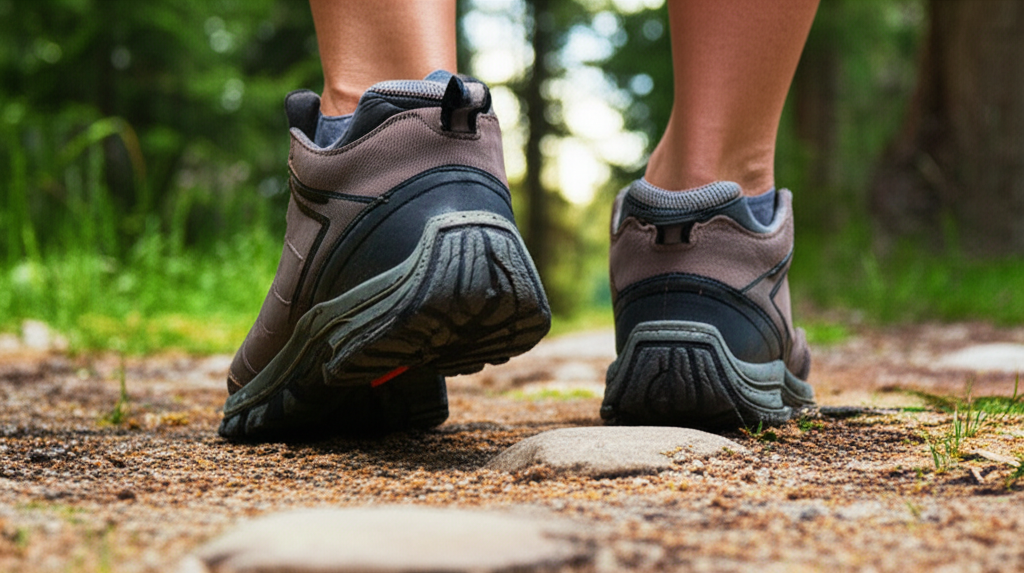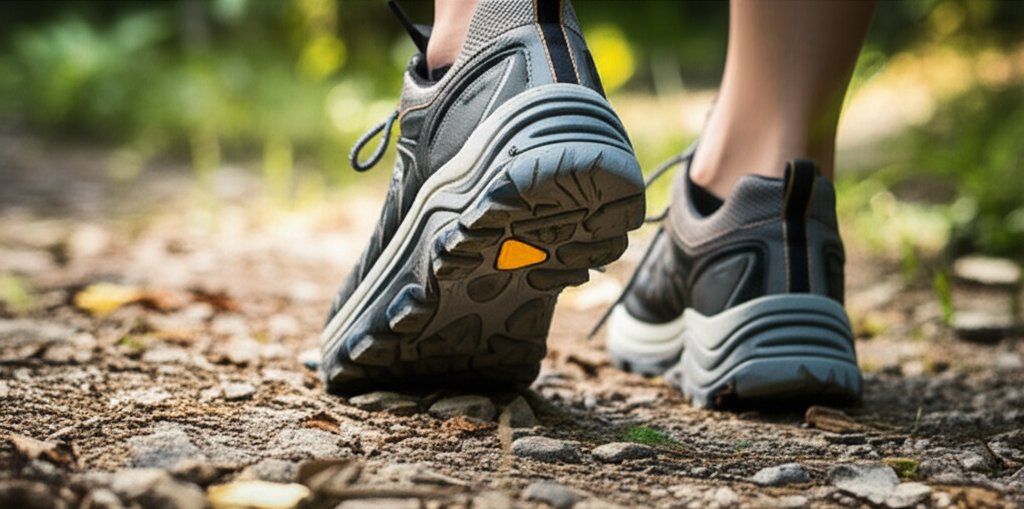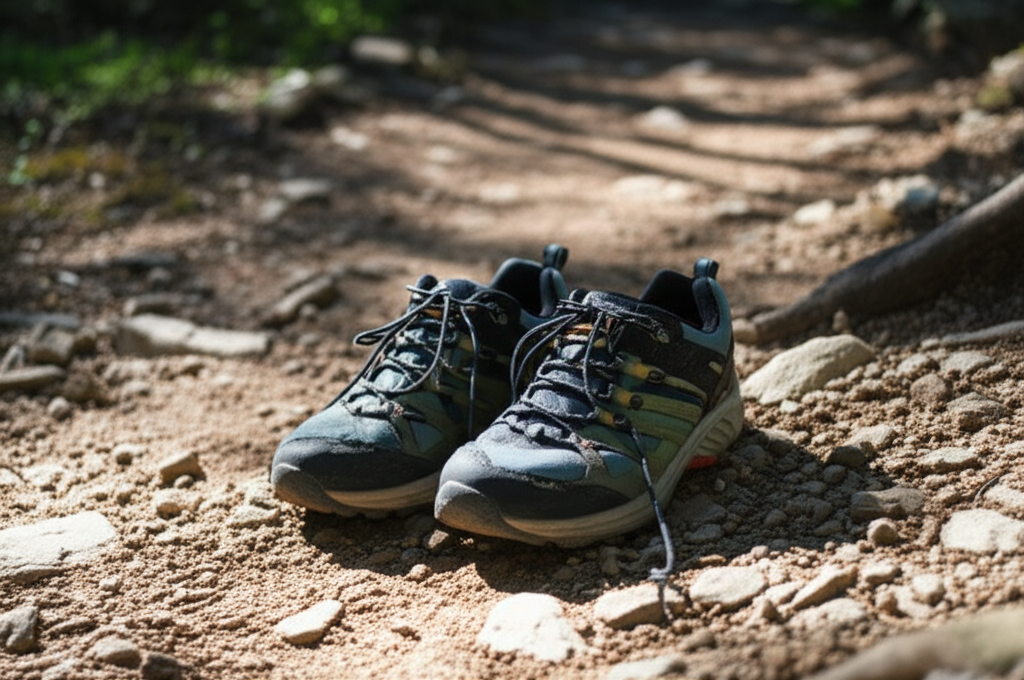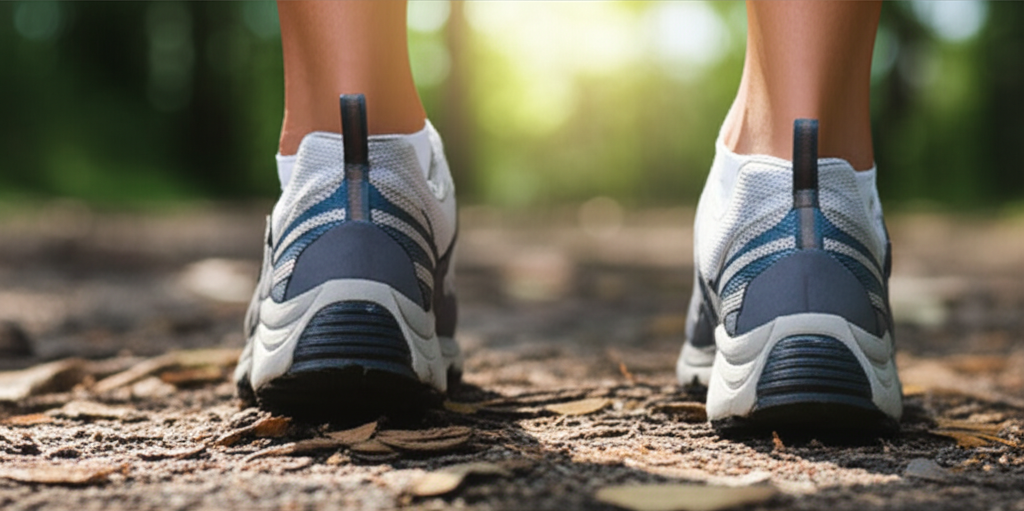Can Walking Shoes Be Used For Trekking? Find Out Now!
Walking shoes can be used for very light, short treks on well-maintained paths, but they are generally not suitable for serious trekking. Trekking requires more ankle support, grip, and durability than typical walking shoes offer. For a better experience and safety on the trail, dedicated trekking or hiking boots are recommended.
Key Takeaways
- Walking shoes offer minimal support for trekking.
- Trekking demands superior grip and durability.
- Ankle support is crucial for uneven terrain.
- Waterproofing is vital for varied trekking conditions.
- Choose specific trekking shoes for safety and comfort.
- Assess your trek’s difficulty before choosing footwear.
Have you ever wondered if your trusty walking shoes could double as trekking boots? It’s a common question, especially when you’re eager to hit the trails but unsure about investing in new gear. The world of footwear can seem a bit confusing, with shoes for running, walking, gym sessions, and of course, trekking. But don’t worry! We’re here to break down exactly what you need to know. We’ll guide you through the differences and help you decide if your current walking shoes are up for the adventure or if it’s time to lace up something more specialized. Let’s explore the trail ahead and make sure your feet are happy every step of the way.
Understanding the Difference: Walking Shoes vs. Trekking Shoes

The fundamental difference between walking shoes and trekking shoes lies in their design purpose. Walking shoes are engineered for comfort and support during everyday activities and moderate walks on flat, stable surfaces. Think city sidewalks, parks, and well-paved paths. Their primary goal is to provide cushioning and flexibility for repetitive, forward motion. Trekking shoes, on the other hand, are built for the challenges of the outdoors. They are designed to handle rough, uneven terrain, varying weather conditions, and the added stress of carrying a backpack. This means they prioritize durability, stability, and protection above all else.
Walking Shoes: Designed for Pavement and Light Trails
When you slip on a pair of walking shoes, you’ll likely notice their immediate comfort and flexibility. They often feature a cushioned midsole to absorb shock from impact, which is great for your joints during long periods of standing or walking on hard surfaces. The outsoles are typically made of rubber and designed for good traction on smooth ground. The uppers are usually made of breathable mesh or soft synthetic materials, keeping your feet cool and comfortable. However, this focus on flexibility and breathability comes with limitations when you step off the beaten path. The materials may not be robust enough to withstand sharp rocks or abrasive surfaces, and the sole’s flexibility can lead to less stability on uneven ground.
Trekking Shoes: Built for Adventure and Rugged Terrain
Trekking shoes, often referred to as hiking boots or trail shoes, are a different breed. They are constructed with durability and protection in mind. You’ll find that trekking shoes offer more ankle support, which is crucial for preventing sprains and twists when navigating rocky or uneven trails. Their midsoles are usually stiffer, providing a stable platform that reduces foot fatigue on longer journeys. The outsoles are a key feature, often featuring deep, aggressive lugs (the patterned bumps) designed to provide superior grip on mud, gravel, and rock. Many trekking shoes also incorporate waterproof and breathable membranes, like Gore-Tex, to keep your feet dry from both external moisture and internal sweat. The uppers are typically made from more robust materials, such as leather or reinforced synthetics, to withstand the rigors of the trail.
Can Walking Shoes Be Used for Trekking? The Short Answer
So, can walking shoes be used for trekking? The answer is a qualified “maybe,” depending heavily on the type of trekking you’re planning. For a short, gentle walk on a well-maintained, relatively flat trail with no significant elevation changes and good weather, your walking shoes might suffice. They could provide adequate comfort for a few hours. However, if your trek involves uneven terrain, steep ascents or descents, loose gravel, mud, water crossings, or carrying a heavier backpack, then walking shoes are generally not the best choice. They lack the necessary support, protection, and grip that dedicated trekking footwear offers, which can lead to discomfort, fatigue, and even injury.
When Walking Shoes Might Be Okay for a Trek
Imagine a leisurely stroll through a national park on a paved or very smooth dirt path. Perhaps you’re going on a short, one-hour walk to a scenic viewpoint that’s easily accessible. In these specific scenarios, your comfortable walking shoes could indeed get you through. They’ll provide cushioning and keep your feet comfortable for the duration. The key factors here are:
- Short Duration: The walk is relatively brief, so fatigue isn’t a major concern.
- Smooth, Stable Terrain: The ground is even, with no significant obstacles like rocks, roots, or steep inclines.
- Light Load: You’re not carrying a heavy backpack, which can shift your weight and stress your ankles.
- Favorable Weather: Conditions are dry and predictable, so waterproofing isn’t an issue.
Even in these situations, it’s wise to be aware of the limitations. A misplaced step could still lead to a twisted ankle if the shoe doesn’t provide enough lateral support.
When Walking Shoes Are NOT Enough for Trekking
The moment your planned trek moves beyond a gentle walk, the limitations of walking shoes become apparent. Here’s when you’ll definitely want to opt for proper trekking footwear:
- Uneven or Rocky Terrain: Trails with rocks, roots, and uneven surfaces require better ankle stability and a stiffer sole to protect your feet from sharp objects and prevent rolls.
- Steep Inclines and Descents: Uphill climbs demand good grip and support, while downhill sections require cushioning and stability to manage the impact and prevent your feet from sliding forward.
- Muddy or Slippery Conditions: Walking shoes often have shallow treads that can easily become clogged with mud, leading to dangerous slips.
- Water Crossings: If you anticipate crossing streams or wet areas, non-waterproof walking shoes will leave your feet soaked, leading to blisters and discomfort.
- Carrying a Backpack: A heavier pack increases the load on your feet and ankles. Trekking shoes provide the necessary support to handle this extra weight comfortably and safely.
- Longer Treks: Extended periods on your feet in less-than-ideal footwear will quickly lead to pain and fatigue.
Key Features of Trekking Footwear to Look For

When you decide to invest in proper trekking shoes, understanding what makes them suitable for the trail is essential. These features are specifically designed to enhance your performance, comfort, and safety in outdoor environments. Don’t just grab the first pair that looks rugged; consider these critical elements:
1. Ankle Support and Height
This is one of the most significant differences. Trekking footwear typically comes in low-cut, mid-cut, and high-cut styles.
- Low-cut: These are essentially sturdy trail shoes that offer more protection and grip than walking shoes but minimal ankle support. They are good for day hikes on well-maintained trails.
- Mid-cut: These extend just above the ankle bone, offering a good balance of flexibility and support. They are versatile for various terrains and suitable for carrying moderate loads.
- High-cut: These fully enclose the ankle, providing maximum support and protection. They are ideal for challenging terrain, multi-day treks, and carrying heavy backpacks.
The level of ankle support you need depends on the terrain and how much weight you’ll be carrying. For beginners on moderate trails, a mid-cut boot is often a good starting point.
2. Outsole Grip and Lug Pattern
The outsole is your connection to the ground. Trekking shoe outsoles are made from durable rubber compounds and feature deep, aggressive lugs. These lugs are designed to bite into soft ground like mud and dirt, providing traction. The spacing between the lugs also matters; wider spacing helps shed mud, preventing it from clogging the tread. A well-designed outsole will offer reliable grip on a variety of surfaces, from wet rocks to loose scree. Look for outsoles from reputable brands known for their grip, such as Vibram.
3. Midsole Cushioning and Stiffness
The midsole sits between the outsole and the upper, providing cushioning and absorbing shock. In trekking shoes, the midsole is usually firmer and stiffer than in walking shoes. This stiffness offers stability on uneven ground, preventing your feet from feeling every single rock and root. It also provides a more robust platform, reducing foot fatigue on long hikes. Materials like EVA (ethylene vinyl acetate) and PU (polyurethane) are common, with PU generally offering more durability and support for heavier loads.
4. Upper Material and Durability
The upper part of the shoe protects your foot and provides structure. For trekking, durable materials are essential.
- Leather: Full-grain leather is highly durable, water-resistant, and molds to your foot over time, offering excellent support. However, it can be heavier and requires a break-in period.
- Split-grain leather and Suede: Often combined with nylon or mesh, these offer a good balance of durability, breathability, and flexibility. They are lighter than full-grain leather.
- Synthetic Materials: Modern synthetics are lightweight, quick-drying, and require minimal break-in. They are often used in combination with mesh for breathability.
Reinforcements around the toe and heel are also common, providing extra protection against abrasion and impact.
5. Waterproofing and Breathability
For trekking in varied conditions, keeping your feet dry is paramount. Many trekking shoes feature waterproof and breathable membranes, such as Gore-Tex (GTX). This technology allows sweat vapor to escape while preventing water from entering the shoe. This is crucial for preventing blisters and maintaining comfort, especially on longer treks where your feet will inevitably get warm and moist. However, it’s worth noting that fully waterproof shoes can be less breathable in very hot and dry conditions.
Comparing Walking Shoes and Trekking Shoes: A Table
To further illustrate the differences and help you make an informed choice, here’s a comparison table:
| Feature | Walking Shoes | Trekking Shoes |
|---|---|---|
| Primary Use | Everyday wear, light walks on paved/flat surfaces | Hiking, trekking on varied, uneven terrain |
| Ankle Support | Minimal to none | Low, mid, or high cut options offering moderate to high support |
| Outsole Grip | Moderate traction for smooth surfaces | Aggressive lugs for superior grip on diverse terrain (mud, rock, gravel) |
| Midsole Stiffness | Flexible for natural foot motion | Stiffer for stability and shock absorption on rough ground |
| Durability | Moderate, suitable for urban environments | High, built to withstand abrasive outdoor conditions |
| Water Resistance | Typically none, focus on breathability | Often waterproof/water-resistant with breathable membranes (e.g., Gore-Tex) |
| Weight | Lightweight | Can range from light trail shoes to heavier boots, generally heavier than walking shoes |
| Protection | Basic toe protection | Enhanced toe and heel protection, underfoot protection from rocks |
Choosing the Right Footwear for Your Trek

Selecting the appropriate footwear is one of the most critical decisions you’ll make as an outdoor enthusiast. It directly impacts your comfort, safety, and overall enjoyment of your adventure. Don’t let the allure of a bargain or the convenience of using what you already have lead you to an uncomfortable or even dangerous situation on the trail.
Assessing Your Trekking Needs
Before you even start looking at shoes, consider the types of treks you plan to do. Ask yourself these questions:
- What kind of terrain will I be on? (Smooth trails, rocky paths, muddy tracks, snow, scree?)
- How long will my typical treks be? (A few hours, a full day, multi-day expeditions?)
- Will I be carrying a heavy backpack? (Day pack, multi-day pack?)
- What are the likely weather conditions? (Dry and hot, wet and cold, unpredictable?)
- What is my experience level? (Beginner, intermediate, advanced?)
Answering these will guide you toward the right category of footwear. For instance, a beginner planning short day hikes on well-maintained trails might be well-served by a sturdy pair of low-cut hiking shoes. Someone embarking on a multi-day backpacking trip in the mountains will likely need mid- or high-cut boots with substantial support and durability.
The Importance of Fit
Regardless of the type of shoe, proper fit is non-negotiable. Even the most technically advanced trekking boot will be useless if it doesn’t fit your foot correctly. Here’s how to ensure a good fit:
- Shop in the afternoon: Your feet swell throughout the day, so trying on shoes later in the day mimics how they’ll feel on a long hike.
- Wear appropriate socks: Bring the type of socks you plan to wear while trekking (wool or synthetic hiking socks, not cotton).
- Check the length: With the shoe unlaced, slide your foot forward until your toes touch the front. You should be able to slip one finger (snugly) between your heel and the back of the shoe.
- Lace them up: Lace the shoes properly, ensuring they are snug but not tight.
- Walk around: Stand up and walk. Pay attention to any pressure points, rubbing, or heel slippage. Your heel should stay relatively locked in place.
- Test on an incline: If possible, use an incline ramp in the store. Your toes shouldn’t jam into the front of the shoe on the descent, and your heel shouldn’t lift excessively on the ascent.
- Consider your foot type: Some people have wide feet, narrow heels, or high arches. Look for brands and models that cater to different foot shapes.
Break-In Period
Most dedicated trekking shoes, especially those made of leather, will require a break-in period. This means wearing them for shorter walks and gradually increasing the distance before embarking on a long trek. This allows the materials to soften and mold to your feet, reducing the risk of blisters and discomfort. Lighter-weight trail shoes often require less break-in time.
Pro Tip: Always carry blister prevention supplies like moleskin or athletic tape on your first few treks with new footwear. Even with a good break-in, unexpected hot spots can develop.
Alternatives to Traditional Trekking Boots
While classic hiking boots are a staple, the market offers a range of footwear suitable for trekking, catering to different preferences and needs.
Trail Running Shoes
These are designed for running on off-road trails. They are lightweight, flexible, and offer excellent grip with aggressive lug patterns. They are a good option for fast-and-light hikers or those who prefer a more minimalist feel. However, they offer less ankle support and underfoot protection compared to hiking boots, making them best suited for well-maintained trails or for experienced hikers who are accustomed to them.
Hiking Shoes (Low-Cut)
These look like beefed-up walking shoes but are built with more durable materials, better traction, and often a stiffer sole. They offer more protection than walking shoes but lack ankle support. They are a great choice for day hikes on moderate terrain or for backpackers who prioritize a lighter weight and don’t need significant ankle protection.
Approach Shoes
Designed for climbers to wear on the approach to a climbing route, these shoes offer excellent grip on rock and are durable. They are often low-cut and can be a good option for hikers who frequently encounter rocky or scrambling sections, though they may lack the cushioning for very long distances.
Can Walking Shoes Be Used For Trekking? Conclusion
In conclusion, while your everyday walking shoes can certainly accompany you on a casual stroll through a park or on a very short, flat, and well-maintained trail, they are generally not the ideal choice for actual trekking. The demands of uneven terrain, varied weather, and the need for enhanced support and protection mean that dedicated trekking footwear—whether it’s hiking shoes, trail runners, or robust boots—is a far safer and more comfortable option. Investing in the right gear ensures your feet stay protected, supported, and happy on your outdoor adventures, allowing you to focus on the beauty of your surroundings rather than foot pain. Always assess the demands of your planned trek and choose footwear that meets those needs for a truly enjoyable experience.
Frequently Asked Questions (FAQ)
Q1: Will my regular athletic shoes work for a light hike?
A1: Regular athletic shoes, like running shoes, might work for a very short, easy hike on a flat, smooth path. However, they typically lack the ankle support, durable outsole, and underfoot protection needed for more challenging terrain. Dedicated hiking shoes or trail runners are a much better choice for any hike beyond a simple walk.
Q2: How much ankle support do I really need for trekking?
A2: The amount of ankle support you need depends on the terrain and your personal preference. For well-maintained trails and lighter loads, low-cut shoes might be sufficient. For uneven, rocky, or slippery terrain, or if you’re carrying a heavier pack, mid-cut or high-cut boots that provide more substantial ankle support are recommended to help prevent twists and sprains.
Q3: Are waterproof walking shoes a good substitute for trekking shoes?
A3: While waterproof walking shoes offer an advantage in wet conditions, they usually don’t have the robust outsole, stiffer midsole, or overall durability required for trekking. The waterproofing is a good feature, but it doesn’t compensate for the lack of specialized construction needed for trails.
Q4: Can I wear my walking shoes on a multi-day trek?
A4: It is strongly advised against wearing walking shoes for multi-day treks. These treks often involve significant mileage, varied terrain, and the weight of a backpack, all of which put considerable stress on your feet and ankles. Walking shoes will likely lead to severe discomfort, fatigue, and a higher risk of injury.
Q5: What’s the difference between hiking shoes and walking shoes?
A5: Hiking shoes are generally more rugged, featuring deeper treads on the outsole for better grip, a stiffer sole for stability, and more durable upper materials than typical walking shoes. Walking shoes prioritize cushioning and flexibility for paved surfaces and offer less protection and support for outdoor trails.
Q6: How important is the grip on trekking shoes?
A6: The grip, or traction, is extremely important for trekking shoes. The aggressive lug patterns on the outsoles are designed to dig into dirt, mud, and gravel, providing stability and preventing slips on varied and often unpredictable surfaces. Good grip enhances safety and confidence on the trail.
Q7: My walking shoes are comfortable, so why can’t I use them for trekking?
A7: Comfort is subjective and can be misleading. Walking shoes are comfortable because they are designed for the repetitive motion and impact of walking on flat surfaces. Trekking involves different forces – lateral movements, uneven surfaces, and potential impacts from rocks or roots – which require specialized support, protection, and grip that walking shoes simply do not provide, even if they feel comfortable initially.

